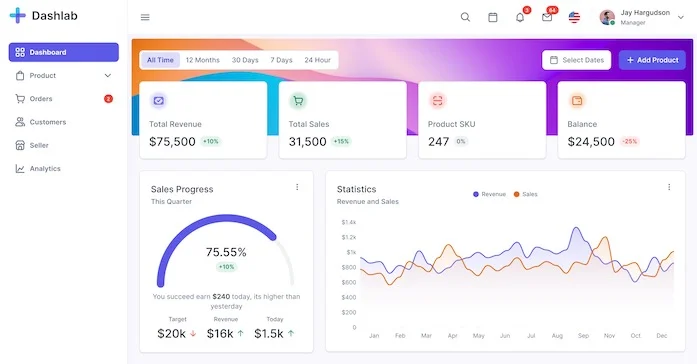It’s no secret that backlinks are one of the major ranking factors. But before you start chasing them like crazy, know that not all backlink types are created equal – some boost your site while others only hurt your rankings.
In this blog, we highlight the types of high-quality backlinks that are worth your time and effort, as well as those that could potentially lead to penalties.
What are backlinks in SEO?
Backlinks represent trust endorsements from other websites to yours. And that trust is shown when another website genuinely finds your content useful and decides to link back to it, enhancing their own content in the process.
And because you’ve provided value, Google and other search engines take notice and may reward you with higher rankings.
Now, that is a simplistic view of how backlinking works.
To be more realistic, there are additional factors and best practices for backlink building you should consider.
For instance, a backlink from an established site carries more weight than one from a newer site. Plus, how you go about getting these links matters (Google can spot if you’ve been paying for links rather than earning them naturally).
Building a solid network of SEO backlinks takes time and effort. It’s often seen as one of the trickier parts of SEO for businesses. However, the payoff can be huge once you get the hang of it.
Types of Backlinks
Before we go deeper into which backlink types to pursue and avoid, understand first that backlinks are also categorised according to link attributes. These link attributes serve as instructions for search engines, telling them how to treat a link in terms of passing on ranking power to the page being linked to.
Dofollow Backlinks
Dofollow backlinks instruct search engines to follow the link, thereby passing link juice to the linked page. These are the types of links that matter for boosting your site’s authority
Typically, you receive dofollow links when another website finds your content or page useful and links back to it.
Unlike other backlink types, dofollow links do not require additional code to specify their nature. Since this is the default linking method, dofollow links are the most common type of backlinks.
Here’s an example of a dofollow link from one of our blogs directing to Backlinko:
” <a href=”https://backlinko.com/google-ctr-stats” title>over 50% of all clicks</a> “
Nofollow Backlinks
On the opposite side of the spectrum from dofollow links are nofollow backlinks. They include the “rel=nofollow” attribute, which tells search engines not to pass on link juice or authority to the linked website.
Using our previous example, a nofollow link would look like this:
<a href=”https://backlinko.com/google-ctr-stats” rel=”nofollow” title>over 50% of all clicks</a>
Nofollow links are commonly used in two situations: when linking to a competitor’s page and when you receive a backlink from a site you don’t want to be associated with. In the latter case, you can request that the site add a nofollow tag to the backlink.
Additionally, nofollow links frequently come from social media, forums, and blog comments.
So, if nofollow links don’t pass any authority, should you still pursue them? Absolutely.
While they don’t contribute to SEO directly, they can provide referral traffic. Moreover, a mix of nofollow and dofollow links indicates natural link building, whereas having only dofollow links can seem suspicious.
Sponsored Backlinks
A sponsored backlink is a type of nofollow backlink specifically used when a backlink is paid for by the website owner.
It includes a rel=”sponsored” attribute, indicating to search engines that the link is paid. Since the link isn’t organic, it doesn’t contribute to boosting your ranking.
And, since paid links are more transactional than focused on promoting helpful content, it makes sense for search engines to treat them accordingly.
However, these links still provide value. Paying for a link from a commercial site relevant to your own and with a high following can drive significant traffic to your site and enhance brand awareness.
UGC Backlinks
User-generated content (UGC) backlinks are another type of nofollow link, identified by the rel=”ugc” attribute in the source code.
When you allow people to leave blog comments on your site, you’re more exposed to spam attacks. To protect your site from potential penalties and maintain its safety, it’s essential to label these links with a ugc tag.
Best Backlinks to Get for Your SEO
To get the best out of your backlinking efforts, we recommend you secure these types of backlinks below.
1. Editorial Backlinks
Editorial backlinks are links acquired organically. They’re earned by creating superior, relevant content that other website authors will naturally want to link to – because it enhances the value of their own content – rather than being paid or requested for.
Below are proven ways to get these powerful backlinks:
- Create original content featuring statistics, case studies, surveys or data analysis. Website authors are likely to cite them as references embedded within the body of their own blog posts or articles
- Build free tools, such as calculators, generators, checklists and assessments. Not only can these earn you backlinks, but they can also increase engagement on your site.
- Use platforms like HARO, Qwoted and Featured to connect with writers and journalists who may be looking for your expertise to quote in their content.
In fact, we’ve garnered many backlinks from high-authority sites using the third method, for example:
Our link from HubSpot:
Our link from Entrepreneur.com

Editorial backlinks are pretty straightforward. Unlike other backlink types which can have a lot of grey areas, editorial backlinks are less likely to trigger any Google penalties or algorithmic changes. It also boosts your topical authority, which is sustainable for your SEO.
2. Guest Post Backlinks
Guest post backlinks are links you acquire by writing blog posts or articles for another website. The arrangement is simple: you provide high-quality content that attracts traffic to their site, and in return, you receive a valuable backlink.
In-body backlinks (like those mentioned in the previous section on editorial backlinks) are common and preferred. However, some website owners may only permit backlinks in the author bio – and that’s fine as it still passes authority to your website.
Look at the example below from Search Engine Journal.

For guest posting to be effective, remember the following guidelines:
- Take time to select the ‘right’ websites for guest posting. They should be high-quality sites with good domain ratings (DR) and positive traffic trends. SEO tools like Ahrefs and Semrush can help you check their credibility.
- Manually identify and steer clear of spammy sites. Things like poor website design, low-quality content and excessive ads are usually signs of a spammy site.
- Remember that guest posting is more than just writing content. You must research topics that will interest the target website and their audience, and craft compelling outreach emails to convince website owners to collaborate.
- Apart from delivering quality content, you can go the extra mile by sharing it with your own followers. This can encourage the website owner to welcome future collaborations, which can mean more backlink opportunities.
As you can see, guest posting goes beyond the usual technicalities of SEO. It requires relationship-building with website owners and making win-win partnerships.
3. Niche Edit Backlinks
If you want to get high-quality links similar to guest posting but without having to create a new post from scratch, niche edit backlinks are good alternatives.
Niche edit backlinks, or ‘link inserts,’ are backlinks you get by simply inserting your webpage link into an already published post or page on a website. This way, you get link juice sooner, unlike guest posting where you have to wait weeks for the post to be indexed.
However, for this backlink type to boost your SEO, you must ensure that:
- the existing content is relevant to your business or industry
- the website hosting the content has strong domain authority and credibility
- the link is naturally integrated into the content, not just added as an afterthought
If you already have high-quality, valuable and unique content to offer, then bulk of the work goes into finding websites that can benefit from these link inserts. You should also take time crafting personalised outreach emails to successfully convince website owners of the link insert’s value.
A common and effective way to find these websites is by looking into branded searches – those searches that explicitly mention your brand. Use a keyword research tool like Ahrefs Keyword Explorer, enter your company or brand, and sort through those mentions to find link insert opportunities.
4. Directory Backlinks
Business listing and review platforms such as Yelp and Yellow Pages allow you to input your business’s name, address and phone (NAP) details and a direct link to your website, which earns you a backlink. Here’s an example from Yelp:

Google has mentioned before that directory links or citations generally don’t help with your SEO. However, there are several reasons to come after these types of links.
For one, these listings send positive signals to search engines about how well-established your business is, which reflects credibility and stability.
Moreover, directory backlinks add diversity to your profile. It provides valuable referral traffic and increases brand awareness, which is particularly good for your Local SEO efforts.
Citation building is fairly simple. Just create a profile on the platform and ensure all your details are consistent. Easy, right? But before you dive in head first, there are a few things to consider.
Since directory backlinks are relatively easy to obtain, some people misuse this approach to acquire too many backlinks at once, attempting to manipulate Google rankings. This often results in penalties.
That said, don’t submit your site to hundreds of directories. Focus on quality, niche-specific directories relevant to your business to ensure your backlinks are of high quality and beneficial to your overall SEO efforts.
5. Broken Backlinks
Broken links are links that lead to pages that are no longer accessible, often resulting in a 404 error. This can occur when the target page has been deleted, moved or the URL has changed without updating the link.
A strategy called broken link building can help you acquire these valuable links. Here’s how it works:
- Find relevant websites that contain these broken links.
- Contact website owners via manual outreach and suggest your content as a replacement.
Once the website owner approves, congrats! You now have a new backlink that further strengthens your site’s authority and credibility.
One advantage of pursuing these broken links is that you’ll earn a backlink from a page that’s already indexed, unlike guest posts which take time to be indexed since they are new content.
Moreover, you are likely to get approval because by informing the website owner about the broken links, you’ve already offered a helpful service. You also have an immediate solution to replace those broken links that can harm their SEO and user experience.
For this approach to work, however, requires time and effort. First, you must ensure that you already have high-quality content that’s better than the original. You must also craft a compelling outreach message to get website owners’ attention effectively.
To speed up the process, you can use broken link checker tools. Afrefs offers a useful free tool you can start with.
6. Image Backlinks
Image backlinks are links on images (or in text placed right under the image), usually to credit the source or creator.
For instance, look at how Demand Curve included an image backlink within the body text of their blog. In this case, Backlinko gets a backlink from them.
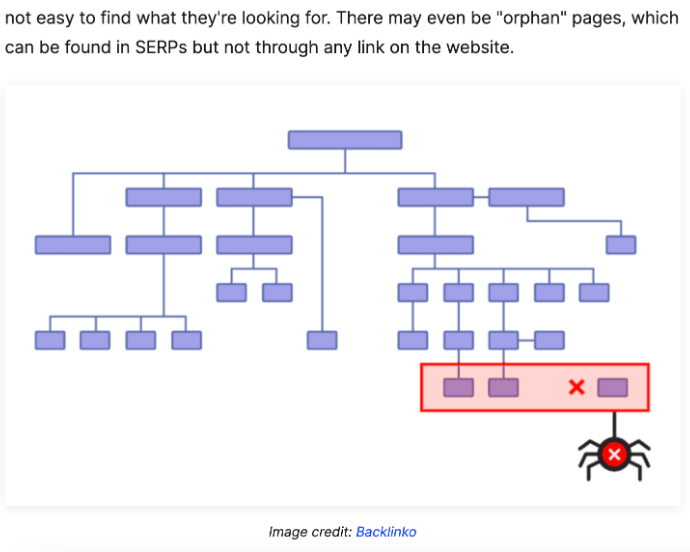
At times, image backlinks can also be found in headers and sidebars, usually in the form of clickable banners.
To obtain these image backlinks, start by creating original, high-quality visuals. Infographics that visually present numerical data, such as graphs and charts, tend to be the most linked to.
Next, take steps to make your image more discoverable. Share your infographics on social media. Additionally, optimise them with descriptive file names and alt tags to improve their visibility on search engine results.
Then comes the real challenge: finding the web pages using your images. Use Google Reverse Image Search to locate these pages and ask the website owners to provide proper credit through a backlink. Ensure the backlink directs to the appropriate pages on your website to maximise its impact.
7. Video Backlinks
Video backlinks work similarly to in-text image backlinks. When a video you’ve created is used by another website owner in their blog or article, and they link to your site to credit you, you’ve earned a video backlink.
However, other website owners might not always give proper credit. In such cases, you’ll need to search for these websites using reverse video search. Renowned digital marketer Neil Patel has detailed how to do this on his blog.
Video links can also come from popular platforms like YouTube, usually found in video descriptions and comments. While these links may not have as strong an SEO impact as direct in-text backlinks, they still provide valuable referral traffic.
8. Badge Backlinks
Badge backlinks are links earned by hosting industry- or niche-specific award programs, for instance, ‘The Webby Awards’ or ‘Semrush AU Search Awards’ in the digital marketing space. Here’s how popular brands do it:
- They create a digital badge, like an award or emblem, that represents a certain achievement, certification or contribution.
- These badges are awarded to websites that meet the brand’s criteria.
- The recipient websites then display the badge on their site, with a link back to the brand’s website.
While this tactic certainly works for established brands, it can also work for growing brands.
The fact is, businesses crave awards. New and growing businesses, in particular, want to display these badges to showcase their credibility and build trust with potential customers. This also helps them connect with larger brands and influencers, making them eager to pursue these awards.
To ensure the effectiveness of these badges in earning backlinks, they must be valuable and desirable. Target specific achievements or offer additional perks, like discounts or content promotion, alongside the badge to further incentivise participation.
9. Social Media Backlinks
When someone makes a social media post or replies to a thread with a link to your web page, you’ve earned a social media backlink. You can also find these on user profiles, such as the Instagram profile of popular copywriter Alex Cattoni below:
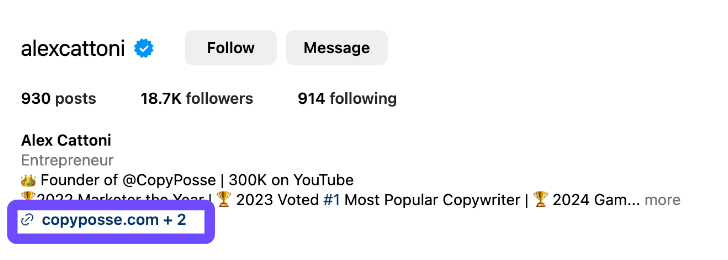
Social media backlinks don’t directly affect your SEO. However, they leave digital footprints that inform Google and other search engines of your online activity. They drive traffic and boost engagement on your site, which are positive ranking signals.
10. Testimonial Backlinks
Remember the last time you came across a product or service you weren’t familiar with? Or, perhaps you had heard of, but weren’t sure of the quality? You likely looked for reviews or testimonials before making a purchase or subscribing.
Given the influence of testimonials, businesses highly value them and may even offer a backlink in exchange for your feedback.
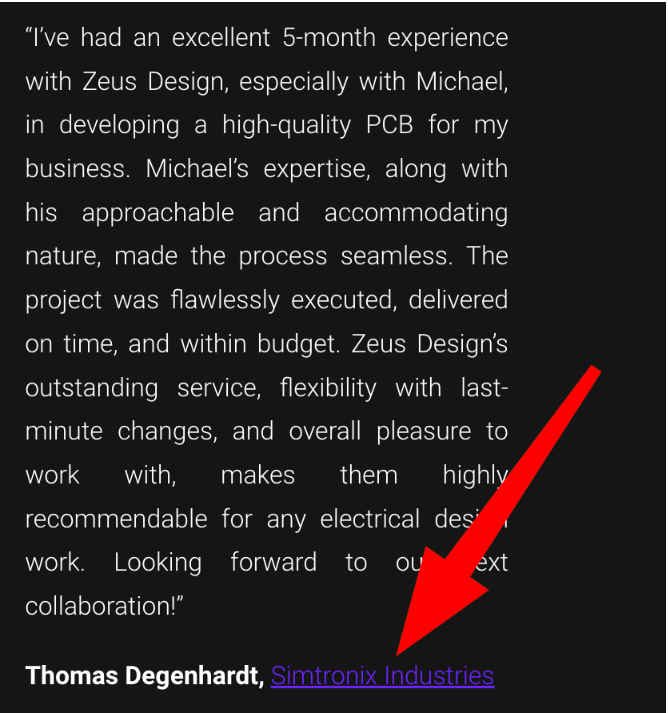
Service providers, in particular, often have a case study section showcasing their results and successes for potential clients. If your website or business was featured in a case study, you can reach out to them and request a link back in exchange for writing a review or testimonial.
11. Resource Page Backlinks
Websites often have a page dedicated to relevant resources like tools (calculators, assessments, etc.) and additional reads – sometimes even featuring other valuable websites. For example, The Hiking Life maintains such a page:
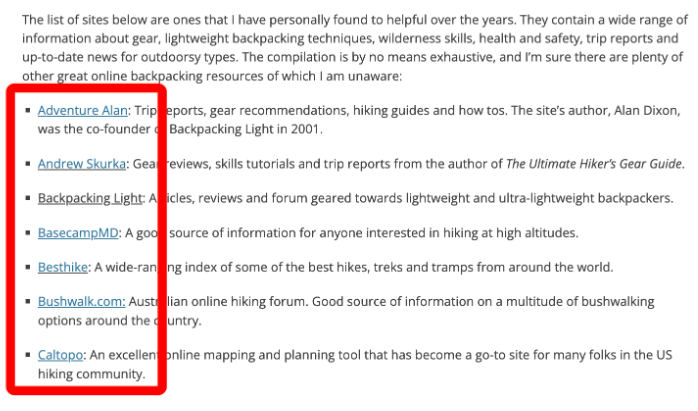
Earning a spot on such a curated page gets you a resource page backlink.
To find these websites, you can perform a simple Google search using a formula like ‘[niche/industry] resource page.’ You’ll find hundreds of them, but it’s important to reach out only to authoritative and legitimate ones.
Obtaining links from too many resource pages can appear spammy and might be penalised by Google for link scheming.
12. Footer Backlinks
Footer backlinks are links placed in the footer section of a website. Web designers or developers often use this strategy as a way to get credit by displaying their brand or company name.
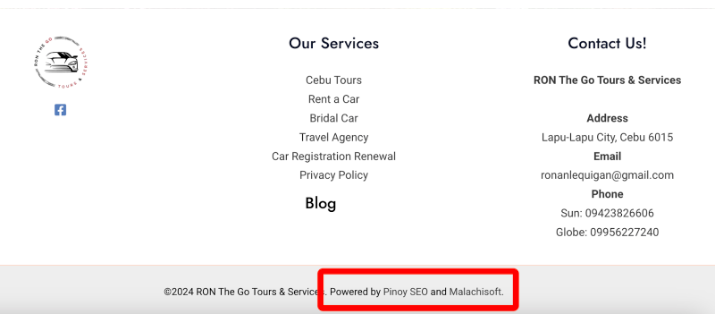
Footers, being a static element of websites, mean links within them are present sitewide. This could mean thousands of pages and therefore, thousands of quality backlinks, right? Not quite.
In fact, Google has penalised websites that exploited this approach as it constitutes unnatural link building. That said, it’s safe to say footer links don’t directly boost your SEO rankings today.
Nevertheless, treat footer backlinks as a bonus – they can still provide exposure to clients of that website and generate referral traffic, which ultimately benefits your overall SEO.
Types of Backlinks to Avoid
Below are the types of backlinks not going after as they either don’t yield results or could get you penalised.
13. Comment Backlinks
On blogs and forum websites, it’s easy to leave comments that include a link to your website – so easy that, at one point, people spammed blog comments to manipulate search rankings (and received penalties as consequence).
Of course, it’s within your control to avoid such practices and instead leave genuine comments that provide value. So, what then is the real issue with pursuing comment backlinks?
Besides the fact that these links often have a ‘no-follow’ tag, meaning they don’t pass on SEO link juice and have minimal impact, website owners or moderators can remove or edit comments, including those with backlinks.
This means the backlinks you acquire through comments can be very temporary. With such an uncontrollable variable, it can be a waste of time and effort to pursue these kinds of backlinks.
14. Private Blog Network (PBN) Links
PBNs are networks of independent sites created to generate backlinks to a target website. Typically, PBNs are created by buying old domains with high authority and then publishing new content that links back to the target site.
Essentially, the purpose of PBNs is to manipulate search engine rankings. Many SEOs boast some success using PBNs but they also expose themselves to being discovered by Google and other search engines whose policies they violate. When detected, your site might suffer a heavy penalty on its SEO performance.
Which is why we strongly discourage the use of PBN links. Instead, we recommend getting backlinks the hard but legitimate way. It may take time and effort but it’s sustainable.
Nevertheless, this does not mean that avoiding PBNs will protect you from a PBN attack.
There are those who might include PBN links to their own websites pointing at yours to ruin your rankings. Regularly auditing your backlink profile plus using tools for disavowing doubtful links can help greatly reduce this risk factor.
15. Backlinks from Shared Guest Post Spreadsheets
As a link builder, you might have come across these online spreadsheets that list hundreds of websites where you can post guest articles at a reasonable price. These sites often have impressive metrics like high Domain Authority and lots of traffic, but there are reasons to be cautious:
- These sites may have had good performance in the past but might not be as effective now.
- These spreadsheets include many websites across different niches, including some that are Private Blog Networks (PBNs), which don’t provide much value.
- These sites obviously prioritise selling links, violating search engine guidelines.
If you ask us, you’d be better off investing your time and resources in studying your competitors’ backlink profiles rather than spending them on sifting through these spreadsheets.
16. Backlinks from the Same Domain
Imagine you’re reviewing a website’s backlink profile. You notice various unique domains, a few appearing once or twice, and then one domain responsible for 20+ backlinks. That should make you pause and raise your eyebrow.
Google and other search engines likely view this pattern with the same suspicion too. They see it as unnatural, suggesting possible link manipulation in ways like reciprocal link exchanges to boost rankings.
The key takeaway is that backlinks should ideally come from different domains. This approach signals a more natural and organic link-building strategy.
Is your backlink strategy paying off?
If you’re seeing positive results, keep up the good work! But if it’s not going as planned, you might have to rethink your approach.
At KBA Web, we offer effective link building services that follow Google’s guidelines. Whether you need a strategy review or hands-on improvements, our team can provide the insights and expertise to enhance your SEO efforts.
Get in touch with us today and start improving your website’s ranking!






